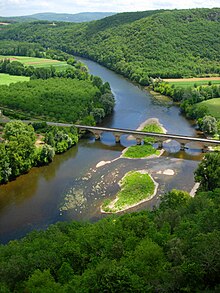The Dordogne is a region of Nouvelle-Aquitaine, France. Dordogne is one of France's best-loved areas.
Castles, châteaux, and other important historical museums are sprinkled throughout the region, offering enough historical interest for any aficionado, but attractively distributed throughout a breathtaking scenery that needs no scholarly tendencies to enjoy it.
While long a favourite with visitors, the region has escaped much of the overdevelopment of some of France's other regions.
Cities
editOther destinations
edit- 1 Montignac - The prehistoric cave paintings of Lascaux. A UNESCO World Heritage site.
- 2 Eygurande-et-Gardedeuil
- 3 Château de Losse in 13 Thonac is an excellent example of a 16th-century French castle, well preserved and with lovely gardens.
Understand
editThe Dordogne department roughly follows the shape of the historic Périgord, a former province and one of the primary battlegrounds during the Hundred Years' War. The name is still commonly used by the French, as the Dordogne is divided into four regions, named after the historic province. They're the Périgord Vert (Green, in the north), the Périgord Blanc (White, in the north-east), Périgord Noir (Black, in the south-east) and the Périgord Pourpre (Purple, in the south-west).
Get in
editGet around
editThere isn't much in the way of public transport around the Périgord Noir area of which Sarlat is the main town. Railway: Trains from Paris to Souillac or Paris to Libourne and then change for Sarlat using the Bergerac line. A number of trains operate from Bordeaux to Sarlat each day, which takes about 3 hours and is a reasonably scenic journey. Bus: There is no bus station in Sarlat but some services operate from the railway station. The Transperigord links Souillac to Sarlat via the Dordogne valley twice daily and the Sarlat Bus services various areas of Sarlat itself. Taxi: There are several taxi companies operating around Sarlat and the Dordogne valley. Taxi Faugére and taxi Cy
See
edit


- Visitors from around the world flock to see the prehistoric caves of Lascaux, thought by many scholars to be the world's best. However, due to the damage resulting from too many people visiting the caves, they have been permanently closed to the public. The French government has built Lascaux II near the site where tourists can see a copy of the original cave.
- A wealth of story-book chateaux such as Losse in Thonac, Château de Beynac in Beynac-et-Cazenac, and the excellent museum of medieval warfare at the fortified Chateau de Castelnaud in Castelnaud-La Chapelle.
- A lovely countryside, dotted by the golden stone houses native to this region, makes Dordogne seem a little like a cross between a fairy tale and a movie set.
- The legendary stone villages of Dordogne, including Monpazier, Rocamadour, Domme and La Roque Gageac, are unforgettably picturesque. The market of Sarlat-la-Canéda is just one of many remarkable markets in the area, but this is one that is truly a shopper's dream come true.
Do
edit- Canoeing down the River Dordogne is a fantastic way to see the region. It is also great for seeing towns and castles.
- Small group tours departing from Sarlat la Caneda with Ophorus.
- The Dordogne is a wonderful area for walking and hiking. There are various good maps of the region or otherwise quite a few local, independent walking holiday providers can help you on your way.
In the region there is some amazing caves full of stalactites and stalagmites.
Eat
editA magnificent cuisine - famous especially for its pâtés - is often rated by native French as the country's best. Some local specialties:
- Pommes Sarladaises -- potatoes roasted in duck fat, with garlic and parsley.
- Confit de canard -- slow-cooked duck leg.
- Foie gras -- liver from the fattened duck (canard) or goose (oie). Although controversial for its production process, foie gras remains a popular delicacy and is prepared in any number of ways, including pâtés.
- Black truffle of Périgord -- best season for this is when it's fresh, late November through February.
- Tourain blanchi -- garlic soup with egg whites.
Drink
editSleep
editAs in most popular holiday destination regions in France, you'll find a range of places to stay, varying from large and small camp grounds and village bed & breakfasts to high end hotels and resorts. Family holiday houses are also widely available.



